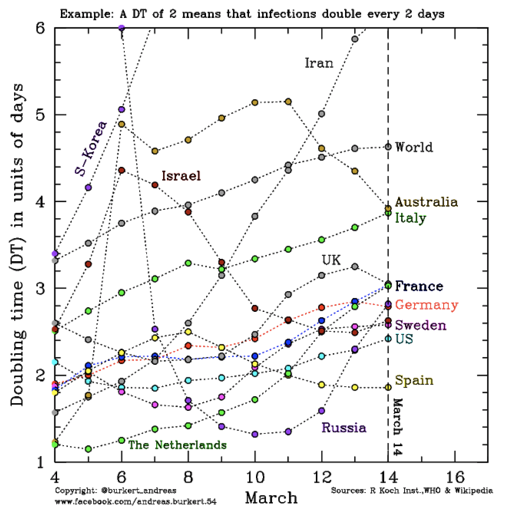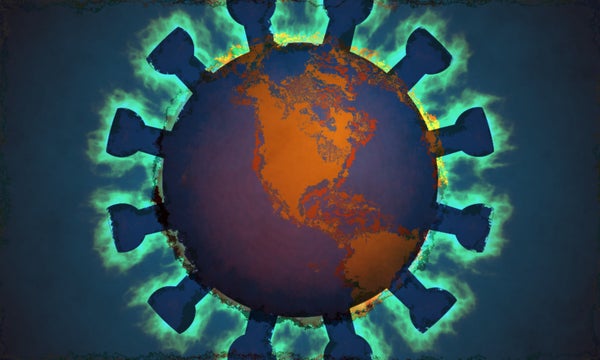This article was published in Scientific American’s former blog network and reflects the views of the author, not necessarily those of Scientific American
What is the best public policy to counter the health risk from the Coronavirus, COVID-19? This is the question on everyone’s mind.
It is wise to try and learn from the current situation in China, where the rate of COVID-19 infections was extinguished as a result of a lockdown, and Italy, where hospitals are full and doctors have to make life-death decisions about patients because there are not enough beds to treat everyone in need. The mortality fraction of infected people appears to be higher by an order of magnitude when hospitals are overcrowded, so suppressing the rate of new infections serves the important purpose of allowing those in need to be treated.
If we do nothing, the current state of affairs is likely to worsen dramatically in the coming weeks. To gauge how bad circumstances may become, let’s examine publicly available data.
On supporting science journalism
If you're enjoying this article, consider supporting our award-winning journalism by subscribing. By purchasing a subscription you are helping to ensure the future of impactful stories about the discoveries and ideas shaping our world today.
Our first plot shows the reported number of infections over time. For each country, Wikipedia has a continuously updated Web site with links to the original official sources such as the World Health Organization, research institutes and health ministries. The plotted curves show the cumulative number of known infections per country as a function of date. Colored points show the current situation as of this writing on March 15.
.png?w=577)
Credit: Andi Burkert
The data exhibit exponential growth in all countries, except for China and South Korea. Because of the rapid growth, early action is crucial in moderating the number of infections. Extrapolating the curves all the way to the edge of the box implies that the United States will reach a million infections at the beginning of April, with four million for Spain and about 0.1 million for the United Kingdom, Netherlands and Sweden, respectively. If no effective action is taken by April 10, the U.S. and the European countries could reach the 10 million mark.
The doubling times appear to evolve, as shown in our second plot. These values represent the slopes of the growth curves, averaged over a period of eight days.

Credit: Andi Burkert
But the number of reported cases must be smaller than the actual number of infections. Many countries, including the U.S., were limited until recently by the availability of COVID-19 test kits. It is possible that there are many more cases than those in public reports. We label those “invisible infections.” South Korea performed many more tests than the U.S. and succeeded in flattening its curve. The COVID-19 tests in the U.S. had a positive fraction that was three to 10 times larger than in South Korea, implying a substantial invisible population.
If the correction factor due to the "invisible population" is a factor of approximately 10 and only about 20 percent of people infected show symptoms (based on the Diamond Princess cruise ship statistics), then the actual number of people exposed to the coronavirus at this time is already five million. This implies: (i) with an approximately 2 percent mortality fraction out of the infected population, at least 100,000 people will die; and (ii) we are only about 10 doubling times away from having most of the worldwide population being infected if no social distancing is established. Given that the measured doubling time is a few days, this implies that uninhibited exponential growth will saturate within a month, leading up to some 100 million deaths. But if many countries flatten the curve, as we all hope, then saturation will take a much longer time and the number of deaths could be reduced.
What does all of this imply? The wisest policy at the moment is to “flatten the curves” and lengthen the doubling times as much as possible by suppressing social interactions. The virus does not move on its own. It is transmitted by humans and survives a few days on contaminated surfaces. To flatten the curves, all nations must engage immediately in social distancing as well as in extensive testing and comprehensive isolation of patients with COVID-19 symptoms and people who had been in contact with such patients.
This policy will reduce crowding in hospitals and minimize the mortality rate in the short term. But one should keep in mind that it does not eliminate the virus and will likely lead to a yo-yo behavior—where, as soon as mobility of people is enabled months from now, the spread of COVID-19 will resume. The spread will saturate once most of the population is infected, as forecast by Angela Merkel, or a vaccine is widely distributed in about a year.
This short-term policy does not take into consideration the economic impact that could lead to a major recession due to loss of income by small businesses, tourism, travel and entertainment, over an extended period of time. The financial implications, combined with the societal and psychological impact of a lockdown, could deteriorate the livelihood of many communities. Bad economic times could lead to deaths of people with low income who are most vulnerable to an economic downturn. There must be a sweet spot that balances the negatives associated with crowding of hospitals versus economic downturn. This sweet spot should be the long-term goal that policy makers aim at.
Overall, there is no doubt that many people will be exposed to COVID-19. As of now, delaying the growth is crucial for reducing the total number of deaths that the COVID-19 will amass. The situation is analogous to waiting after rush hour before driving our cars in order to minimize the death toll from collisions. The optimal strategy of policy makers must be to buy as much time as possible, so that hospitals will not be overcrowded. Let’s all work together to flatten the growth curves shown above. By doing so, we could save many lives. And as stated in the Talmud: “whoever saves a single life, saves the whole world.”
Read more about the coronavirus outbreak here.
